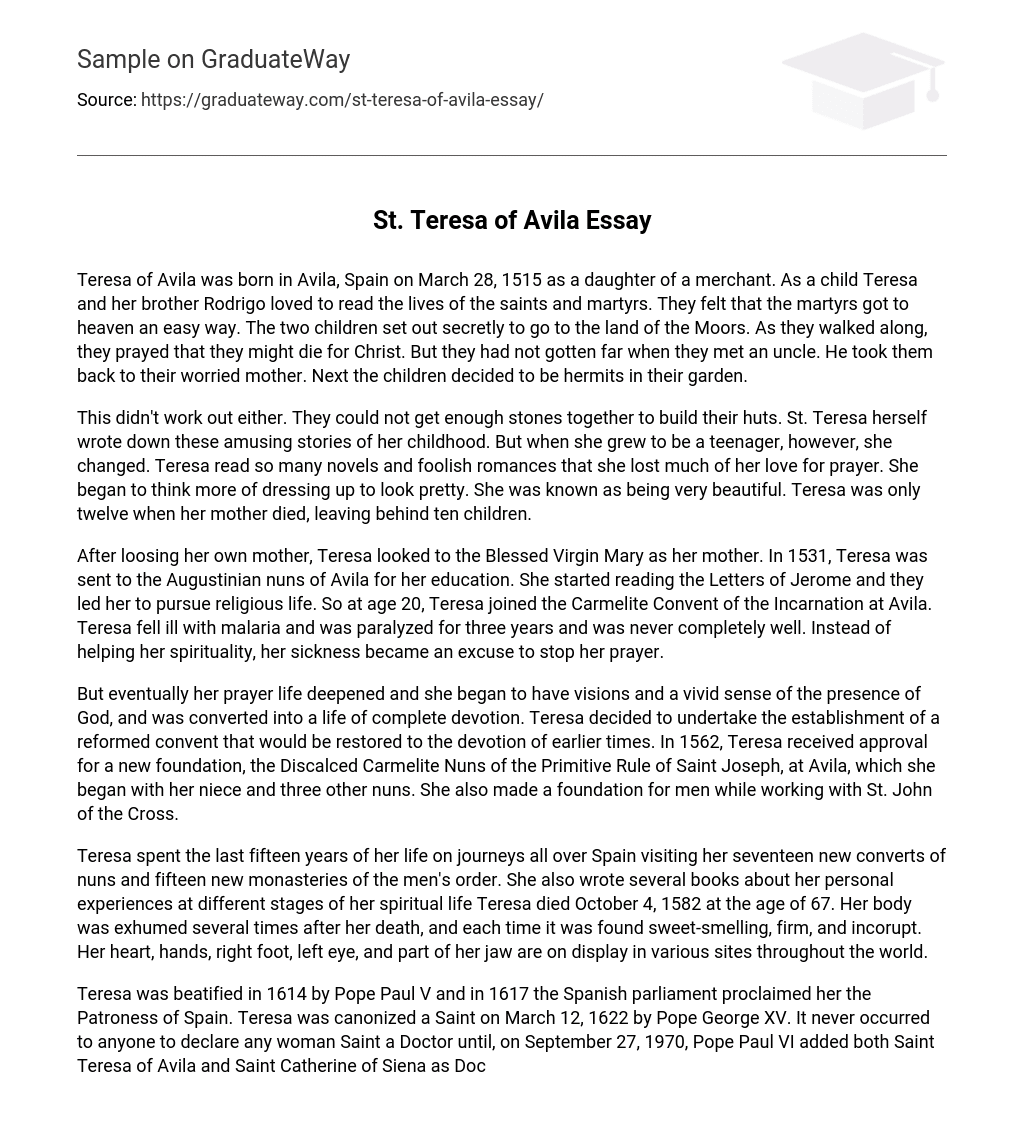Teresa of Avila, born in Avila, Spain on March 28, 1515, was the daughter of a merchant. During her childhood, Teresa and her brother Rodrigo were enthusiastic readers who enjoyed gaining knowledge about saints and martyrs. They believed that martyrs had a direct path to heaven. Motivated by their desire to sacrifice themselves for Christ, the two children embarked on a covert journey to Moorish lands. However, their plans were disrupted when they encountered their uncle who promptly brought them back home to their concerned mother. Unfazed by this setback, the siblings then decided to become hermits in their garden.
This attempt also failed – they were unable to gather sufficient stones for their huts. St. Teresa herself recorded these entertaining stories from her youth, but during her teenage years, she experienced a change. Teresa dedicated a significant amount of time to reading numerous novels and frivolous romances, which led to a decreased fervor for prayer. She started placing more importance on her looks and adorning herself to enhance her attractiveness, gaining renown for being exceptionally beautiful. Regrettably, at the age of twelve, Teresa’s mother died, leaving behind ten children.
Following the loss of her own mother, Teresa sought solace in the Blessed Virgin Mary as a maternal figure. In 1531, she was sent to the Augustinian nuns of Avila for her education where she discovered Jerome’s Letters, which fueled her desire for a religious life. Subsequently, at 20 years old, Teresa joined the Carmelite Convent of the Incarnation in Avila. Unfortunately, she contracted malaria and remained paralyzed for three years. Although she eventually recovered from her illness, Teresa never fully regained her health and used her sickness as a reason to cease praying.
Eventually, her prayer life became more profound and she started experiencing visions and a strong awareness of God’s presence. This led to her conversion and a commitment to a life fully devoted to God. Teresa then decided to establish a reformed convent that would return to the early traditions of devotion. In 1562, she obtained approval for a new foundation called the Discalced Carmelite Nuns of the Primitive Rule of Saint Joseph in Avila. She commenced this endeavor with her niece and three other nuns. In addition, she collaborated with St. John of the Cross to create a foundation for men.
Teresa spent the last fifteen years of her life exploring Spain, visiting seventeen new nuns who converted and fifteen new monasteries for men. Moreover, she wrote several books documenting her own encounters during her spiritual expedition. Teresa died on October 4, 1582, at 67 years old. Her remains were unearthed multiple times posthumously and each time they remained fragrant, preserved, and unaltered. Different places globally exhibit her heart, hands, right foot, left eye, and a portion of her jaw for public view.
Teresa was beatified in 1614 by Pope Paul V and declared the Patroness of Spain by the Spanish parliament in 1617. She was later canonized as a Saint on March 12, 1622, by Pope George XV. Prior to September 27, 1970, no woman had been named a Doctor of the Church. However, on that date, Pope Paul VI bestowed this title upon both Saint Teresa of Avila and Saint Catherine of Siena. In 1997, Pope John Paul II designated Teresa of Lisieux as the third female Doctor of the Church. Additionally, Saint Teresa of Avila is recognized as the Patron saint for lace makers, religious individuals, those suffering from headaches or sicknesses and for Spain.
With a heart, an arrow, and a book as her symbol, Saint Teresa of Avila was once an ordinary girl who encountered challenges in praying and prioritizing God in her life, just like anyone else. However, she exemplifies that anyone can seek holiness and delight in prayer. Through her journey, Saint Teresa of Avila realized that she found happiness during prayer and in practicing her faith. She persistently strived to maintain joyfulness and famously implored, “May God protect me from saints burdened with sadness.”





